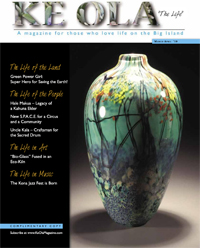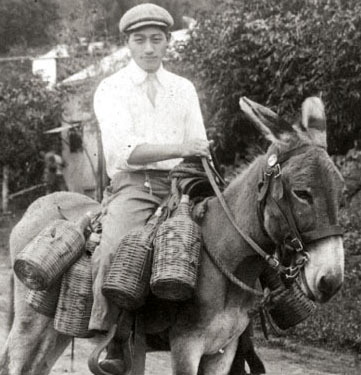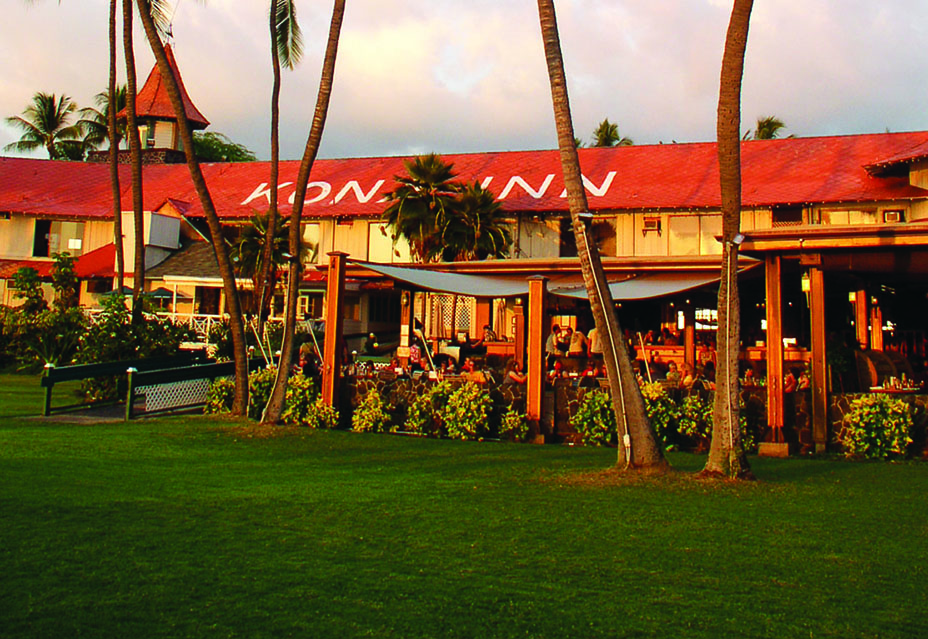
Then & Now: Wai‘ōhino
By Ann C. Peterson
Driving through the sleepy little village of Wai‘ōhinu, tucked into a lush, green valley near the larger village of Na‘alehu, it’s hard to believe that it was once the economic hub of Ka‘u. Rich in early settlement and historical references, it was described by Mark Twain as one of his favorite places to visit on the Big Island.

1998, in spite of much opposition by its parishioners and local residents.
‘Wai‘ōhinu’ means “water shining like oil” in Hawaiian, and it is this natural resource that helped shaped the village’s destiny. In the time of the early Hawaiians, a series of mountaintop springs named Ha‘ao branched out at the base of the steep pali over a series of terraced taro patches that were encircled by villagers’ homes. Some say that Wai‘ōhinu’s name described the sun’s bright reflection on this water, but there are also a few legends attributed to the naming of the town.
Two of the naming legends involve Tahitian kupua, or supernatural beings. In the first, a cruel ogre came to Ka‘u and dwelt with his wife and son just below Ha‘ao, causing all kinds of death and havoc to those visiting the springs. They hid the corpses in the tall grasses and when a heavy rain brought the oil (hinu) from the bodies down the stream, villagers realized what had been happening, captured the ogre and his son with a clever ruse, and cooked them in an imu. In another legend the kupua were stones— a black male stone named Ka‘uloa and a red female one named Wai‘ōhinu. Legend states that these stones liked to talk to each other, and as they conversed, they kept going deeper and deeper into the ground until Ka‘uloa became the whole district of Ka‘u—with its black lava landscape, and the female stone became the red-dirt land of Wai‘ōhinu.
The earliest-known, written account of Wai‘ōhinu was made by Archibald Menzies, the surgeon and botanist on Captain George Vancouver’s voyage in 1794. Their Voyage of Discovery landed at Waio‘ahukini—a sandy beach just west of Ka Lae (South Point), and after a day’s travel found Wai‘ōhinu, “the most populous village since Kealakekua.” Menzies noted that the “neatness with which they cultivated their little fields made the whole valley appear more like a rich garden than a plantation;” and he goes on to describe “a stream of water which fell from the mountain, though the middle of it was ingeniously branched off on each side to flood and fertilize the most distant fields at pleasure.”
Perhaps because Ka‘u is the most remote district on the island, it was the last to experience a western religious influence. At one time the district had approximately 10,000 inhabitants, but those numbers have declined since then due to many factors. In 1841, French Catholic Father Marechal settled at Wai‘ōhinu, and while Congregationalism and Protestantism were the more popular religions in the other districts, Father Marechal “wore his shoes out before he could repair them,” and by 1846, two-thirds of Ka`u’s inhabitants were Catholic.

Reverend John D. Paris also arrived in Wai‘ōhinu in 1841 and built Ka‘uaha‘ao Church—the first of eight churches he was to build in the districts of Ka‘u and Kona. He built this church of lava stone and white mortar, with a thatched roof, and “big enough to hold a thousand or more people but generally with 300–400 in attendance,” according to an early traveler. In 1888, following its destruction in the great earthquake of 1868, the church was rebuilt of wood with a tall steeple painted white with green trim. A historic landmark at Wai‘ōhinu, it was a scenic treat to all who saw it, and its controversial destruction in 1998 is still a sore topic among Wai‘ōhinu residents and preservationists throughout the state.
Without a doubt, the most famous early visitor to Wai‘ōhinu was Mark Twain, who arrived in 1866. Landing at Ka`alu`alu Bay he traveled on horseback the six miles to the village as the “surroundings fast improved,” and they were “soon among green groves and flowers and occasional plains of grass.” He was enchanted with the trees, particularly the mango and orange trees that “will live in my memory as the greenest, freshest, and most beautiful I ever saw—and withal, the stateliest and most graceful.” Twain stayed with Captain Charles N. Spencer, who later served as Minister of the Interior for King Kalākaua, and the two each planted a monkey pod tree along the roadway. Twain’s tree was blown down in the late 1950s, but a shoot survived and has grown into a beautiful shade tree with a historical marker claiming its fame.
On April 2, 1868, Mauna Loa erupted and a subsequent 7.7 magnitude earthquake killed seven people in Ka‘u, injured 40 and damaged 550 houses. Every building in Wai‘ōhinu was destroyed.
It was also in 1868 that Alexander Hutchinson established the first commercial sugar operation in Na‘alehu. Water was critical for the early cane fields—to move the cane along the flumes to the harbor. The beautiful Ha‘ao stream was diverted for this use, and the source of Wai‘ōhinu’s celebrity disappeared from the lower lands.
In March of 1877, the Hawaiian Gazette noted, “for a small village, Wai‘ohinu has a large number of stores–at least 10, which supply the wants of the inhabitants residing in the Ka‘u district, 20 miles in either direction.” The article gives a glowing review of the community’s “neat appearance” and the resident’s “habits of industry,” and states that there “is no good reason” that a “substantial wharf not be built” at Ka‘alu‘alu Bay. However, the decision to instead build a new wharf at Honu‘apo—also known today by some as Whittington Beach Park—seems to be a turning point for the village. As the burgeoning sugar industry was developed further east, in Na‘alehu and Pahala, Wai‘ohinu’s heydays as an economic hub were over.
Wai‘ōhinu made the switch from urban to rural with gentle grace. The beautiful green backdrop of rolling hills is fertile pastureland and lush with a myriad of trees and vegetation. In the center of town, Wong Yuen Store, retains the name of the Chinese immigrant who began its operations in 1914. Shopping there takes one back to a more personable, slower time. Outside the store, on the northeast side of the building is a mural that depicts scenes from the 1800s. Here you can see how the stream branched out over the land, you can see the church, and of course, Mark Twain is there amongst the villagers. ❖


